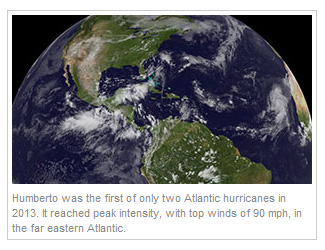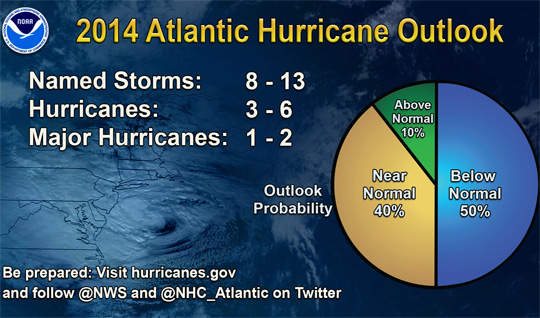NOAA Predicts Slower Atlantic Hurricane Season
May 23, 2014
In its 2014 Atlantic hurricane season outlook issued today, NOAA’s Climate Prediction Center is forecasting a near-normal or below-normal season.
The main driver of this year’s outlook is the anticipated development of El Niño this summer. El Niño causes stronger wind shear, which reduces the number and intensity of tropical storms and hurricanes. El Niño can also strengthen the trade winds and increase the atmospheric stability across the tropical Atlantic, making it more difficult for cloud systems coming off of Africa to intensify into tropical storms.
 The outlook calls for a 50 percent chance of a below-normal season, a 40 percent chance of a near-normal season, and only a 10 percent chance of an above-normal season. For the six-month hurricane season, which begins June 1, NOAA predicts a 70 percent likelihood of 8 to 13 named storms (winds of 39 mph or higher), of which 3 to 6 could become hurricanes (winds of 74 mph or higher), including 1 to 2 major hurricanes (Category 3, 4 or 5; winds of 111 mph or higher).
The outlook calls for a 50 percent chance of a below-normal season, a 40 percent chance of a near-normal season, and only a 10 percent chance of an above-normal season. For the six-month hurricane season, which begins June 1, NOAA predicts a 70 percent likelihood of 8 to 13 named storms (winds of 39 mph or higher), of which 3 to 6 could become hurricanes (winds of 74 mph or higher), including 1 to 2 major hurricanes (Category 3, 4 or 5; winds of 111 mph or higher).
These numbers are near or below the seasonal averages of 12 named storms, six hurricanes and three major hurricanes, based on the average from 1981 to 2010. The Atlantic hurricane region includes the North Atlantic Ocean, Caribbean Sea and Gulf of Mexico.
“It only takes one hurricane or tropical storm making landfall to have disastrous impacts on our communities,” said Joe Nimmich, FEMA associate administrator for Response and Recovery. “Just last month, Pensacola, Florida, saw five inches of rain in 45 minutes – without a tropical storm or hurricane. We need you to be ready. Know your risk for hurricanes and severe weather, take action now to be prepared and be an example for others in your office, school or community. Learn more about how to prepare for hurricanes at www.ready.gov/hurricanes.”
Comments
9 Responses to “NOAA Predicts Slower Atlantic Hurricane Season”




Don’t listen to forecasts and prognostications. In 1992, everything was quiet until the the middle of August, the first named storm hit Homestead, Fl. It roared across the Gulf, went up through Mississippi, into Tennessee, where I was at the time. My family was in Pensacola. It’s name…”Andrew.” It only takes one storm to be a disaster.
Thank you William for tidbit of information, i was curious myself.
The way it sounds none of the people commenting have to work in these conditions so lets all hope and pray that we don’t see any kind of storm, AMEN
Now I’m worried. lol
>>>Sounds like the same prediction we got when we were slammed by Ivan, Dennis, etc.
Your comment sparked my curiosity, so I did a little quick research, and this year’s forecast is the exact opposite of 2004 and 2005.
The forecasts:
2014 — 50% chance of BELOW normal season, only 10% of above normal
2005 (Dennis) — 70% chance of ABOVE normal, only 10% of below normal
2004 (Ivan) — 50% chance of ABOVE normal, only 10% of below normal
Of course it’s the ONE hurricane that hits our area that really matters, not how many there are total.
Sounds like the same prediction we got when we were slammed by Ivan, Dennis, etc.
Fred, that’s just an inconvenient truth!
This will be the year we have a big one!! Last two years they’ve said it was gonn b more active than usual an we had none. So watch out this year. Lot of pine cones this year just like it was before Ivan.
Wait, didn’t we all just this week hear that climate change was going to cause weather disasters and kill us all?